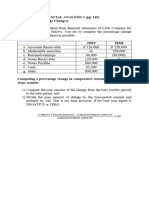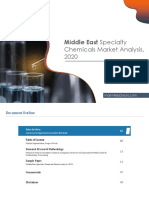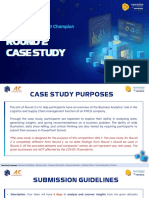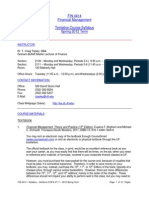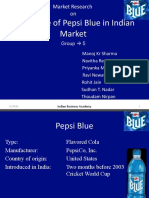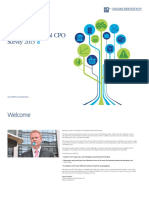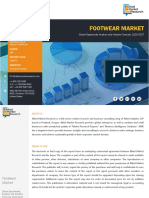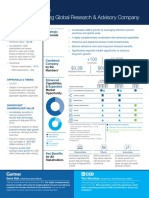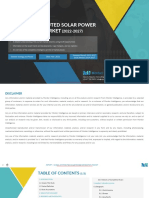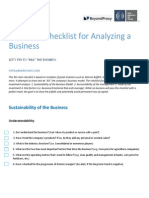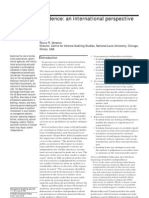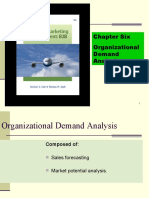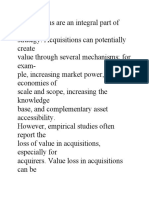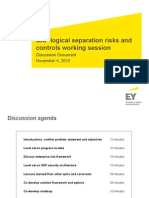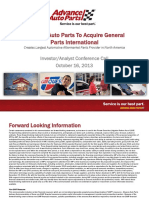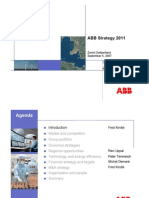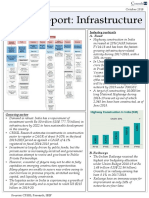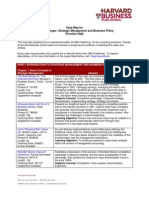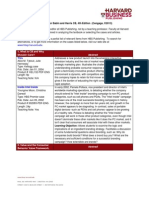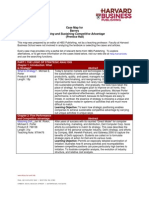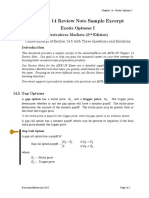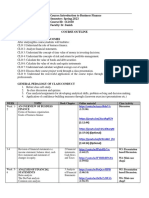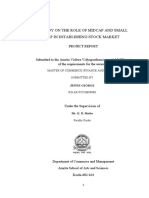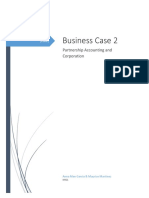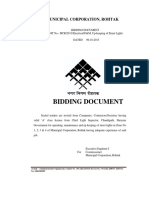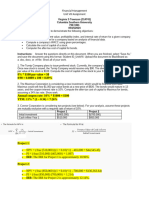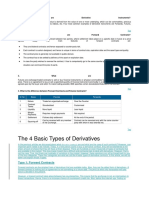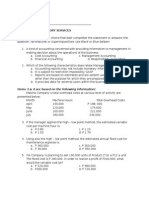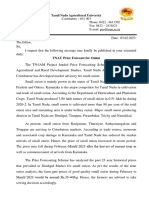Datar Case Maps
Datar Case Maps
Uploaded by
meherey2kCopyright:
Available Formats
Datar Case Maps
Datar Case Maps
Uploaded by
meherey2kOriginal Description:
Original Title
Copyright
Available Formats
Share this document
Did you find this document useful?
Is this content inappropriate?
Copyright:
Available Formats
Datar Case Maps
Datar Case Maps
Uploaded by
meherey2kCopyright:
Available Formats
Case Map for Horngren, Foster & Datar: Cost Accounting: A Managerial Emphasis (Prentice Hall)
This map was prepared by an experienced editor at HBS Publishing, not by a teaching professor. Faculty at Harvard Business School were not involved in analyzing the textbook or selecting the cases and articles. Every case map provides only a partial list of relevant items from HBS Publishing. To explore alternatives, or for more information on the cases listed below, visit: hsbp.harvard.edu
Chapter 1: The Accountants Role in the Organization N/A Chapter 2: An Introduction to Cost Terms and Purposes Carver Consulting Co.: William J. Bruns Jr. Product #: 199006 Length: 7p
Abstract
Daniel Dobbins Distillery, Inc.: William J. Bruns Jr. Product #: 189065 Length: 7p Teaching Note: 189172
Abstract The managing partner of a relatively new consulting firm is concerned because training costs at the firm's new training center are higher than expected. Analysis of actual costs compared to those expected is required. In addition, he is considering capitalizing some training costs for later amortization. A management control system for the center is also a priority. Subjects Covered: Accounting policies; Control systems; Cost analysis; Financial analysis; Financial statements; Management accounting; Management controls A distiller increases whiskey production and income declines because of accounting methods in use. Questions are raised regarding the treatment of expenditures, which can be classified as production, inventory, or period costs. The necessary aging process raises added questions about prior period restatements and needed financing. Subjects Covered: Accounting procedures; Cost allocation; Cost analysis; Financing; Inventory management
Chapter 3: Cost-VolumeProfit Analysis Hollydazzle.com: Ratna Sarkar Product #: 100066 Length: 5p
Prestige Telephone Co.: William J. Bruns Jr. Product #: 197097 Length: 4p Teaching Note: 197098
Abstract Describes the underlying economics of a start-up Internet retailing company. Highlights the fact that costs in that setting have a component that varies with volume and thus seriously impacts profitability. Learning Objective: To focus on the unusual cost-volume-profit relationship at an e-tailer. An independent regulated telephone company has established a computer services subsidiary that seems to remain unprofitable. Managers must determine whether it is profitable or not and consider changes in pricing or promotion that might improve profitability. Learning Objective: To introduce concepts of relevant costs,
Mueller-Lehmkuhl GmbH: Robin Cooper, Dagmar Bottenbruch Product #: 187048 Length: 13p Teaching Note: 187049
contribution, and breakeven analysis. Mueller-Lehmkuhl sells apparel fasteners and rents attaching machines. It views these two products as effectively a single item and prices them accordingly, the fasteners at high profit and its attaching machines at a loss. The cost system allocates the cost of the attaching machines to the fasteners. The Japanese have entered the market and found a way to unbundle the two products. As a result they are challenging the European way of doing business. The case asks the student to analyze the true cost and profitability of the products. Subjects Covered: Cost accounting; Cost allocation; Cost analysis; Profitability analysis; Strategic planning; Strategy formulation Abstract A small company in the graphic arts business faces severe price competition. The company has to respond by cutting costs and making process improvements. Learning Objective: To introduce job costing, activity-based costing, cost controls, process improvements, and product pricing concepts in a very simple setting.
Chapter 4: Job Costing Colorscope, Inc.: V.G. Narayanan, Joseph Cha Product #: 197040 Length: 16p Teaching Note: 198110
Chapter 5: Activity-Based Costing and Activity-Based Management Owens & Minor, Inc. (A): V.G. Narayanan, Lisa Brem Product #: 100055 Length: 17p Teaching Note: 100100
Insteel Wire Products: ABM at Andrews: V.G. Narayanan, Ratna Sarkar Product #: 198087 Length: 9p Teaching Note: 198111 Activity-Based Management at Stream International: Robert S. Kaplan, Norman Klein Product #: 196134 Length: 25p Teaching Note: 198079
Abstract Examines the use of activity-based (or menu) pricing at Owens & Minor (O&M). A manager at O&M, a large national medical and surgical distribution company, enlisted the help of both logistics and cost managers to develop an innovative pricing schedule based on the customer's activities instead of product price. The existing cost-plus pricing structure made it impossible for O&M to price services appropriately. However, he encounters customer resistance to his new proposal. Learning Objective: To introduce students to activity-based pricing/menu-pricing in a medical supply distribution company. Insteel implements an ABC system in 1996. It finds pallet nails to be its most profitable product and decides to expand the number of cells making pallet nails from two to four. A repeat of the ABC study in 1997 shows pallet nails have become the least profitable product. Learning Objective: To explore cost allocation in the presence of excess capacity. Describes the design and implementation of an activity-based costing project undertaken by Stream International's Crawfordsville, Indiana, facilities. After analyzing the costs assigned to 161 work activities, Crawfordsville managers present five proposals for change based on ABM results, then meet to decide which to implement. Learning Objective: To provide an example of activity-based costing and to encourage the analysis of change proposals based on activitybased management. A British bank with strong roots in the cooperative movement encounters declining profitability in an increasingly competitive and deregulated financial services industry. It attempts to grow by
The Co-operative Bank: Robert S. Kaplan, Srikant M. Datar Product #: 195196
Length: 17p Teaching Note: 198078
Wilkerson Co.: Robert S. Kaplan Product #: 101092 Length: 4p Teaching Note: 104002
Kanthal (A) : Robert S. Kaplan Product #: 190002 Length: 13p Teaching Note: 190115
broadening its customer base and increasing the range of products and services offered. It turns to activity-based costing as part of its reengineering effort to learn more about the process and product costs and customer profitability, and contemplates what actions to take based on this new information. Subjects Covered: Activity-based costing; Cost accounting; Cost analysis; Cost systems; Management accounting The president of Wilkerson, faced with declining profits, is struggling to understand why the company is encountering severe price competition on one product line while able to raise prices without competitive response on another product line. The controller proposes that the company develop an activity-based cost model to understand better the different demands that each product line makes on the organization's indirect and support resources. Learning Objective: Students estimate the new cost model, which provides a radically different perspective on product line profitability. They can suggest actions, based on the new cost model, to improve the company's profitability. Multinational company needs an improved cost system to determine the profitability of individual customer orders. Its strategy is to have significant sales and profitability growth without adding additional administrative and support people. The new cost system assesses a charge to each customer order received and an additional surcharge if the item ordered is not normally stocked. The goal is to direct sales resources to the most profitable customers: those who buy standard products in large predictable quantities with minimal demands on technical resources. Subjects Covered: Cost accounting; Cost allocation; Cost systems; Customer relationship management; Management accounting; Sales strategy
Chapter 6: Master Budget and Responsibility Accounting Cafes Monte Bianco: Building a Profit Plan: Robert L. Simons, Antonio Davila Product #: 198088 Length: 8p Teaching Note: 101044 Walker and Company: Profit Plan Decisions: Robert L. Simons, Ramsey Walker Product #: 197084 Length: 12p Teaching Note: 100005
Abstract Using an income statement, balance sheet, and projected demand and cost schedules, students are required to build a profit plan for a closely-held coffee manufacturer in Italy. Students must estimate cash flow and ROE and use this analysis to evaluate the attractiveness of a new strategy. Subjects Covered: Performance measurement; Planning systems; Profit planning; Profitability analysis; Return on investment Ramsey Walker, a second-year MBA student, must decide how to control a family business as an absentee owner. After providing background details on the publishing industry, the case requires the reader to: 1) make a product segmentation decision; 2) prepare a profit plan; 3) calculate free cash flow effects; 4) determine key accounting performance measures; and 5) assess new control systems and their implementation. Subjects Covered: Control systems; Market segmentation; Profit planning; Profitability analysis; Return on investment
Chapter 7: Flexible Budgets, Direct-Cost Variances, and Management Control Software Associates: Robert S. Kaplan Product #: 101038 Length: 5p Teaching Note: 107088
Abstract The president of a small consulting firm has just seen his secondquarter profit and loss statement, showing an increase in revenues but a substantial decline in profits. He asks his chief financial officer to explain the results in a meeting the next day. The CFO works hard to accumulate information so she can explain the impact of the quantity of billed hours, billing rates, consultant expenses, operating expenses, and the shifting mix of business between the two principal product lines. Learning Objective: To learn the fundamentals of variance analysis and flexible budgeting in the context of a professional service firm, without the complications that arise in manufacturing firms of overhead absorption and fixed-cost volume variances. Describes the cost control system used at an automobile engine plant for labor and overhead costs. The finance staff prepares daily, weekly, and monthly variance reports against budgets. Department supervisors, finance staff, and the plant manager discuss the use and interpretation of these reports. Also describes the company's budgeting procedures, which include a performance improvement factor to motivate annual productivity gains and cost reductions. Allows the class to discuss whether the extensive and detailed variance analysis systems promote valuable managerial objectives such as cost control, learning, and improvement. A big issue is whether an emphasis on meeting short-run budgets inhibits longerterm improvements in quality and productivity. Subjects Covered: Cost control; Cost systems; Management accounting; Plant management; Variance analysis A privately owned German power tool company was dissatisfied with its existing cost system. The system could not produce timely, accurate reports on cost center operations, and newly purchased automated machines were attracting large overhead costs. A new, highly automated system was designed and installed that used 600 cost centers and an appropriate activity base chosen for each center. The case shows the design of a highly accurate cost control system with flexible budgets used in both support and production cost centers. Subjects Covered: Budgeting; Cost control; Cost systems; Management accounting
Peoria Engine Plant (A) (Abridged): Robert S. Kaplan, Amy P. Hutton Product #: 197099 Length: 14p
Metabo GmbH & Co. KG: Robert S. Kaplan, Dagmar Bottenbruch Product #: 189146 Length: 14p Teaching Note: 191098
Chapter 8: Flexible Budgets, Overhead-Cost Variances, and Management Control N/A Chapter 9: Inventory Costing and Capacity Analysis Micro Devices Division: Robin
Abstract
Abstract The company has excess capacity. The case explores the various
Cooper, Christopher D. Ittner Product #: 191073 Length: 13p Teaching Note: 191175 Polysar Ltd.: Robert L. Simons Product #: 187098 Length: 13p Teaching Note: 187198
issues surrounding accounting for the cost of capacity. Several definitions of capacity can be discussed and accounted for. Subjects Covered: Capacity analysis; Cost accounting; Cost allocation; Cost systems Canada's largest chemical company produces and markets butyl rubber in two divisions, each treated as a profit center. The new plant in the North American Division operates below capacity, resulting in a significant volume variance and an operating loss. The European Division is at capacity and is profitable. The actions of the European Division affect the capacity utilization of the North American Division. Includes divisional financial statements and interviews with the vicepresidents of each division. Subjects Covered: Budgeting; Capacity planning; Performance measurement; Profit centers; Variance analysis Abstract A British bank with strong roots in the cooperative movement encounters declining profitability in an increasingly competitive and deregulated financial services industry. It attempts to grow by broadening its customer base and increasing the range of products and services offered. It turns to activity-based costing as part of its reengineering effort to learn more about the process and product costs and customer profitability, and contemplates what actions to take based on this new information. Subjects Covered: Activity-based costing; Cost accounting; Cost analysis; Cost systems; Management accounting The company has committed to major improvements in quality, cost, and on-time delivery performance. Despite strong senior management support, however, the actual rate of improvement was disappointing until a new measurement philosophy was introduced. The new approach specified expected rates of improvement and compared actual improvements to the expected rate. Operational people preferred the new measures to the monthly financial reports they continued to receive. The case explores the conflicts between financial measurements and operating improvements. Subjects Covered: Cost control; Learning curves; Management accounting; Productivity; Quality control The division has recognized the inadequacies of its existing, traditional cost system for estimating product costs. Describes the innovative activity-based system that was developed to more accurately trace overhead costs to individual products. Provides students with the opportunity to critique a standard cost system and to assess the characteristics of the proposed system that traces costs to production activities. Subjects Covered: Activity-based costing; Cost accounting; Cost allocation; Cost systems; Manufacturing Abstract An independent regulated telephone company has established a computer services subsidiary that seems to remain unprofitable. Managers must determine whether it is profitable or not and consider
Chapter 10: Determining How Costs Behave The Co-operative Bank: Robert S. Kaplan, Srikant M. Datar Product #: 195196 Length: 17p Teaching Note: 198078
Analog Devices, Inc.: The HalfLife System: Robert S. Kaplan Product #: 190061 Length: 26p Teaching Note: 191103
John Deere Components Works (A): Robert S. Kaplan, Artemis March Product #: 187107 Length: 19p Teaching Note: 188049
Chapter 11: Decision Making and Relevant Information Prestige Telephone Co.: William J. Bruns Jr. Product #: 197097
Length: 4p Teaching Note: 197098 Catawba Industrial Co.: Francis J. Aguilar Product #: 191053 Length: 4p Teaching Note: 894058
Bridgeton Industries: Automotive Component & Fabrication Plant: Robin Cooper, Patricia J. Bost Product #: 190085 Length: 7p Teaching Note: 191168
changes in pricing or promotion that might improve profitability. Learning Objective: To introduce concepts of relevant costs, contribution, and breakeven analysis. A department general manager has to decide whether or not to add a lightweight compressor to the line, what price to charge, and what volume to produce. The analysis requires maximizing contribution in a situation where one factor is constrained. As such, it takes into account opportunity costs and shadow prices as well as fixed and variable costs, demand curve analysis, and sunk costs. Also invites discussion about the proper measurement, offering departmental profits and return on sales as candidates. Subjects Covered: Capacity analysis; Cost analysis; Demand analysis; Machinery; Pricing; Quantitative analysis Bridgeton Industries was experiencing reduced sales. To become more competitive it introduced a classification procedure for products based upon their productivity and other factors. Products were classified into three groups: world class, potentially world class, and non-world class. The firm outsources the non-world class products. This outsourcing causes the costs on the remaining products to increase because some costs associated with the outsourced products dont go away. These residual costs caused more products to become non-world class and hence candidates for outsourcing. The firm has entered the death spiral. Subjects Covered: Budgeting; Corporate strategy; Cost accounting; Cost allocation Abstract Examines the use of activity-based (or menu) pricing at Owens & Minor (O&M). A manager at O&M, a large national medical and surgical distribution company, enlisted the help of both logistics and cost managers to develop an innovative pricing schedule based on the customer's activities instead of product price. The existing cost-plus pricing structure made it impossible for O&M to price services appropriately. However, he encounters customer resistance to his new proposal. Learning Objective: To introduce students to activity-based pricing/menu-pricing in a medical supply distribution company. Explores Toyota's target costing system, considered to be the most advanced such system of any major Japanese manufacturer. Specifically, describes Toyota's process of setting rigorous costreduction goals and the steps taken to achieve them. Subjects Covered: Cost accounting; Cost control; Design; Product development Explores Olympus Optical's strategic response to major losses in its camera business. Key to Olympus's recovery were its extensive product planning process, a quality improvement program, and an aggressive cost-reduction program. In particular, the case details Olympus's target costing system, which enabled the firm to design high-quality products at low cost. Subjects Covered: Cost control; Cost systems; Product development Describes the various value engineering techniques used by Isuzu.
Chapter 12: Pricing Decisions and Cost Management Owens & Minor, Inc. (A): V.G. Narayanan, Lisa Brem Product #: 100055 Length: 17p Teaching Note: 100100
Toyota Motor Corp.: Target Costing System: Robin Cooper, Takao Tanaka Product #: 197031 Length: 10p Olympus Optical Co. Ltd. (A): Cost Management for Short Life Cycle Products: Robin Cooper Product #: 195072 Length: 12p Teaching Note: 195074 Isuzu Motors Ltd.: Cost
Creation Program: Robin Cooper, Takeo Yoshikawa Product #: 195054 Length: 15p Teaching Note: 195055 Nissan Motor Co. Ltd.: Target Costing System: Robin Cooper Product #: 194040 Length: 20p Teaching Note: 195063
Shows how Isuzu reduces the cost of its products while increasing their functionality within the constraints of a target cost. Subjects Covered: Cost control; Product development
Describes Nissan's sophisticated target costing system in the context of new product introduction. On the basis of consumer analysis and a life cycle contribution study, Nissan conducts an exhaustive analysis of component costs to determine whether a new model can be profitably manufactured. Cost reduction measures are then pursued both internally and with suppliers to ensure that the model can be produced to the target cost. The target costing system is central to Nissan's continued competitiveness in the fiercely contested Japanese automobile market. Subjects Covered: Cost accounting; Cost control; Design; Product development; Product introduction
Chapter 13: Strategy, Balanced Scorecard, and Strategic Profitability Analysis Boston Lyric Opera: Robert S. Kaplan, Dennis Campbell Product #: 101111 Length: 21p
Pillsbury: Customer-Driven Reengineering: Robert S. Kaplan Product #: 195144 Length: 28p Teaching Note: 199021
Abstract The Boston Lyric Opera was the fastest growing opera company in North America during the 1990s. Having successfully completed a move to a larger facility in 1999, the board and general director recognize the need to develop a formal strategic planning and governance process to guide the company into the future. Board members, senior managers, and artistic leaders use the Balanced Scorecard as the focus of a strategic planning process that develops a strategy map and objectives in the four BSC perspectives for three core strategic themes. This case describes the high-level scorecard development, its cascading down to departments and individuals, and the directors' interactions, using the Balanced Scorecard, with the artistic leaders and board of directors. Learning Objective: To demonstrate to students how the Balanced Scorecard is used for strategic planning and performance management in a performing arts organization. To serve as an introductory class on the Balanced Scorecard or as a follow-up session after the scorecard has been introduced in a traditional forprofit setting. Pillsbury is transforming itself from an integrated producer of flour and bakery products to a value-added supplier of premium branded products. After initial successes applying activity-based costing to manufacturing operations, two senior executives decide to collaborate to propose a major reengineering project across the company's entire value chain. The case describes the project's definition and scope to yield projected annual cost savings and margin improvement between $100 and $300 million. Subjects Covered: Activity-based costing; Business process reengineering; Cost analysis; Customer relationship management; Management accounting
Chemical Bank: Implementing the Balanced Scorecard: Robert S. Kaplan, Norman Klein Product #: 195210 Length: 19p Teaching Note: 198090
The retail bank division of Chemical Bank faces declining margins and increased competition in its credit and deposit gathering and processing business. It wishes to implement a new strategy to become a preferred financial service provider to target customer groups. The division adapts the Balanced Scorecard to clarify and communicate the new strategy and to identify the key drivers for strategic success. The case describes the development of strategic objectives and measures for four perspectives: financial, customer, internal, and learning growth, and the process for implementing the new measurement and management system. Subjects Covered: Implementing strategy; Management accounting; Performance measurement
Chapter 14: Cost Allocation, Customer-Profitability Analysis, and Sales-Variance Analysis Insteel Wire Products: ABM at Andrews: V.G. Narayanan, Ratna Sarkar Product #: 198087 Length: 9p Teaching Note: 198111 Cambridge Hospital Community Health Network: The Primary Care Unit: V.G. Narayanan, Ryan Moore, Lisa Brem Product #: 100054 Length: 19p Teaching Note: 101007
Wilkerson Co.: Robert S. Kaplan Product #: 101092 Length: 4p Teaching Note: 104002
Abstract Insteel implements an ABC system in 1996. It finds pallet nails to be its most profitable product and decides to expand the number of cells making pallet nails from two to four. A repeat of the ABC study in 1997 shows pallet nails have become the least profitable product. Learning Objective: To explores cost allocation in the presence of excess capacity. Examines a pilot activity-based costing program at the Primary Care Unit (PCU) of the Cambridge Hospital Community Health Network. The network needed to gain a better understanding of its unit-ofservice costs, which had been rising at a rate of 10% per year. The network's current step-down costing system gave only aggregate costing information, and there was some concern that it was inaccurately representing the true cost of the intern/resident program, the interpretive services department, and the use of nurse practitioners. Provides detailed exhibits on the methods of allocating costs using activity-based drivers. Students are encouraged to examine both the data and methodology of the pilot study. Learning Objective: To help students gain an understanding of how activity-based costing models are designed in the health care industry and to examine both the data and the methodology of the pilot study in the case. The president of Wilkerson, faced with declining profits, is struggling to understand why the company is encountering severe price competition on one product line while able to raise prices without competitive response on another product line. The controller proposes that the company develop an activity-based cost model to understand better the different demands that each product line makes on the organization's indirect and support resources. Learning Objective: Illustrates motivation and design for an activitybased cost system. Students estimate the new cost model, which provides a radically different perspective on product line profitability. They can suggest actions, based on the new cost model, to improve the company's profitability.
Chapter 15 Allocation of Support Department Costs, Common Costs and Revenues Chapter 16: Cost Allocation: Joint Products and Byproducts N/A Chapter 17: Process Costing N/A Chapter 18: Spoilage, Rework and Scrap N/A Chapter 19: Balanced Scorecard: Quality, Time, and the Theory of Constraints Lehigh Steel: V.G. Narayanan, Laura E. Donohue Product #: 198085 Length: 15p Teaching Note: 198112
Abstract
Abstract Abstract
Abstract
Abstract Lehigh Steel is a specialty steel manufacturer that plummeted from record profits to record losses in less than three years, driven by an inability to distinguish between profitable and unprofitable business. The scale and growth of service activities and overhead costs in an increasingly customized product line suggests that ABC could unlock the secrets of profitability. However, the high fixed-cost structure suggests that the theory of constraints (TOC) could also be relevant. How should Lehigh measure profitability to rationalize its products? Learning objective: To demonstrate to students that Accounting methods must reflect the economics of the business, the time horizon, and the nature of the decision. To assess the relevance of various costs and the structure (fixed or variable) to calculate profitability relevant to a product mix decision over a certain time horizon. The company has committed to major improvements in quality, cost, and on-time delivery performance. Despite strong senior management support, however, the actual rate of improvement was disappointing until a new measurement philosophy was introduced. The new approach specified expected rates of improvement and compared actual improvements to the expected rate. Operational people preferred the new measures to the monthly financial reports they continued to receive. The case explores the conflicts between financial measurements and operating improvements. Subjects Covered: Cost control; Learning curves; Management accounting; Productivity; Quality control Texas Instruments implements a Cost of Quality (COQ) system as part of a company-wide "Total Quality Thrust." After several years of operation, group management questions whether or not the COQ system should be updated to make it more useful in identifying areas for quality improvement. The case documents the current system and asks students to analyze the role it played in the quality control process and areas in which it could be improved. Subjects Covered: Cost accounting; Cost systems; Manufacturing; Quality control; Systems design; Total quality
Analog Devices, Inc.: The HalfLife System: Robert S. Kaplan Product #: 190061 Length: 26p Teaching Note: 191103
Texas Instruments: Cost of Quality (A): Robert S. Kaplan, Christopher D. Ittner Product #: 189029 Length: 16p Teaching Note: 189112
Chapter 20: Inventory Management, Just-in-Time, and Simplified Costing Methods Supply Chain Management at World Co. Ltd.: Ananth Raman, Anna McClelland, Marshall L. Fisher Product #: 601072 Length: 21p Teaching Note: 601147 Raychem Corp.: Interconnection Systems Division: Clayton M. Christensen Product #: 694063 Length: 17p Teaching Note: 695012
Abstract Describes a supply chain with very quick (i.e., two week) response times and allows students to explore how such short response times are achieved. Allows students to explore why other supply chains, with much longer response times, might not be able to replicate this performance. Learning Objective: To illustrate the need and value of response times to short-lifecycle product supply chains and how response times can be reduced through process and organizational changes. Describes the highly successful efforts of a management team to turn around the performance of a $30 million Raychem division that manufactures electronic connectors. The original manufacturing system was a batch operation, with a broad product line, high inventories, and slow throughput time. Describes the process of converting the operation to a low-inventory, just-in-time plant, organized by manufacturing cells. Shows how it was done, and the impact it had on different categories of overhead cost. Learning Objective: Can be used for two purposes: 1) explains how to manage the transition of an organization to one based upon just-intime manufacturing, and 2) can be used to show in detail the cost structure of a manufacturing organization, describing how costs change when just-in-time principles are adopted. Describes a comprehensive manufacturing strategy designed to reduce substantially the cycle time of orders (the time between the placement of an order by a customer and its delivery to the customer). To launch the strategy, Digital has adopted manufacturing resource planning (MRP II). The case allows students to assess the pros and cons of the strategy, which requires rapid information flows and tight manufacturing discipline; the usefulness of MRP II, which integrates manufacturing with overall business plans; and the implementation process to date. Subjects Covered: Implementing strategy; Inventory management; Manufacturing strategy; Operations management; Plant management Abstract Phuket Beach Hotel has an opportunity to lease its underutilized space to a karaoke pub and earn a rental income. Alternatively, the hotel could develop the unused space and create its own pub. The general manager of the hotel must decide which of the two capital projects to recommend to the hotel owners. This case presents sufficient information to build cash flow forecasts for each project and to rank the mutually exclusive projects using various evaluation criteria. Subjects Covered: Capital budgeting An individual is considering the development of a new restaurant. To make the decision, she uses NPV analysis to determine whether she should undertake the investment, and if so, the optimal size of the investment.
Digital Equipment Corp.: The Endpoint Model (A): David A. Garvin, Janet Simpson Product #: 688059 Length: 14p Teaching Note: 691047
Chapter 21: Capital Budgeting and Cost Analysis Phuket Beach Hotel: Valuing Mutually Exclusive Capital Projects: Su Han Chan, Ko Wang, Mary Ho Product #: HKU145 Length: 4p Teaching Note: HKU146
Ginnys Restaurant: Mark Mitchell Product #: 201099 Length: 2p
Teaching Note: 202013 Dixon Corp.: The Collinsville Plant (Abridged): Peter Tufano, Ronald W. Moore Product #: 201097 Length: 14p Reto S.A.: William J. Bruns Jr. Product #: 197102 Length: 2p Teaching Note: 197109
Learning Objective: To introduce net present value analysis. Specialty chemical company Dixon must decide whether to acquire Collinsville, a business in a new segment, and how much to pay. Learning Objective: To practice in applying free cash flow valuation methods. The company must decide whether to acquire new equipment to offer a new product line. The question is whether equipment will meet return on investment targets considering depreciation and taxation of profits. The equipment is acquired, but one year later, better equipment becomes available. Learning Objective: To review all major issues to be considered in analyzing new equipment proposals. Disequilibrium in the $350 million TiO2 market has prompted Du Pont's Pigments Department to develop two strategies for competing in this market in the future. The growth strategy has a smaller internal rate of return than the alternative strategy due to large capital outlays in early years and positive cash flows arising only in later years. However, it is the more valuable project on a net present value basis for all discount rates less than 21%. Students must convert strategic plans and objectives into free cash flow projections and determine a breakeven discount rate between these mutually exclusive projects. They must then decide which strategy to pursue. Subjects Covered: Capital budgeting; Financial management; Present value; Return on investment; Strategic planning
E.I. du Pont de Nemours & Co.: Titanium Dioxide: W. Carl Kester, Robert R. Glauber, David W. Mullins Jr., Stacy S. Dick Product #: 284066 Length: 7p Teaching Note: 289005
Chapter 22: Management Control Systems, Transfer Pricing, and Multinational Considerations Airtex Aviation: Brian J. Hall, Carleen Madigan Product #: 800269 Length: 16p
Abstract Two young and inexperienced MBAs buy a virtually bankrupt company. They design a decentralized control system organized around profit centers. As a case in control systems, there is ample detail for discussion of design issues, control of independent profit centers, and details about decentralized control. Subjects Covered: Control systems; Decentralization; Entrepreneurship; Information systems; Management accounting; Profit centers A self-contained exercise that takes students through five stages of growth in an entrepreneurial start-up in the medical devices industry: 1) founding, 2) growth, 3) push to profitability, 4) refocus on process, and 5) takeover by new management. At each stage, students must confront tensions in balancing profit, growth, and control. Difficulties encountered in the business are due to management's attempts to design and use formal control systems to achieve profit and performance goals. Learning Objective: Longitudinal study of company attempting to balance innovation and control. Describes Kyocera's unusual approach to profit centers. The firm's
ATH Technologies, Inc.: Making the Numbers: Robert L. Simons Product #: 108092 Length: 14p Teaching Note: 108097
Kyocera Corp.: The Amoeba
Management System: Robin Cooper Product #: 195064 Length: 12p Teaching Note: 195065
J Boats: Robert L. Simons Product #: 197015 Length: 18p Teaching Note: 199042
basic units of operation are profit centers called "amoebas," which are sales or manufacturing units with full responsibility for their planning, decision making, and administration. Amoebas are expected to find ways to improve production and lower costs, reflecting the belief of Kyocera's founder that profits are generated during the manufacturing process. Subjects Covered: Cost accounting; Organizational design; Profit centers; Transfer pricing Traces the 20-year evolution of a family-owned, entrepreneurial sailboat company. Illustrates how two founders leveraged their design and marketing skills to build one of the most recognized brands in the recreational boating industry. Ends as the founder considers management succession and the need to improve financial planning and control systems to capitalize on brand value. Illustrates how entrepreneurs successfully utilize the levers of control by focusing on core values, risks to be avoided, critical performance variables, and strategic uncertainties in a small, family-run business. Learning Objective: To illustrate how entrepreneurs successfully manage a small, family-run business by focusing on core values, risks to be avoided, critical performance variables, and strategic uncertainties
Chapter 23: Performance Measurement, Compensation, and Multinational Considerations Vyaderm Pharmaceuticals: Robert L. Simons, Indra A. Reinbergs Product #: 101019 Length: 15p Teaching Note: 101043
Abstract In 1999, the new CEO of Vyaderm Pharmaceuticals introduces an Economic Value Added (EVA) program to focus the company on long-term shareholder value. The EVA program consists of three elements: EVA centers (business units), EVA drivers (operational practices that improve EVA results), and an EVA-based incentive program for bonus-eligible managers. Over the next two years, the implementation of the program runs into several stumbling blocks, including resistance from regional managers, who push for "line of sight" EVA drivers; the difficulty of managing a large number of EVA centers; and unexpected bonus adjustments due to poor EVA performance. The decision point focuses on the competitive situation in a business unit where the sudden exit of a competitor produces an unexpected one-time "windfall" in earnings. Vyaderm's top managers struggle with the question of whether to adjust the EVA results to prevent demoralizing managers in future years when EVA results are likely to decline. Learning Objective: To allow students to calculate EVA bonus payouts using a pharmaceutical company example. Guidant is a successful IPO start-up selling pacemakers and defibrillators. The case describes how managers install systems to balance innovation and control. Three parts of a shareholder value strategy are described. Controls include incentive systems, beliefs systems, and risk-management systems. Subjects Covered: Control systems; Implementing strategy; Incentives; Planning systems; Risk management
Guidant Corp.: Shaping Culture Through Systems: Robert L. Simons, Antonio Davila Product #: 198076 Length: 17p Teaching Note: 199056
Citibank: Performance Evaluation: Robert L. Simons, Antonio Davila Product #: 198048 Length: 9p Teaching Note: 199047
Mobil USM&R (A): Linking the Balanced Scorecard: Robert S. Kaplan Product #: 197025 Length: 19p Teaching Note: 198044
Citibank has introduced a new, comprehensive performancescorecard system. A regional president struggles with a tough decision: how to evaluate an outstanding branch manager who has scored poorly on an important customer satisfaction measure. This case provides a scoring sheet to be completed by the reader and an explanation of the ramifications of the decision for the business's strategy. Subjects Covered: Control systems; Implementing strategy; Incentives; Performance appraisals; Performance measurement The CEO of the marketing and refining division of a major oil company is in the midst of implementing a profit turnaround. He transforms the strongly centralized, functionally-organized division into 17 independent business units and 14 internal service companies. The division also launches a new, market-segmented strategy aimed at high-end buyers. The CEO recognizes, however, that the new organization and strategy require a new measurement system. He turns to the Balanced Scorecard (BSC) because of its ability to link measurement to strategy, and to help the new profitcenter managers develop customized strategies for their local responsibilities. The case describes the development of the initial divisional BSC, the linkage of the divisional BSC to independent business unit and internal service company BSCs, and linkage of the BSC to managers' compensation. Concludes with the senior executives reflecting on how they are using the BSC in their management processes. Subjects Covered: Cost accounting; Executive committees; Implementing strategy; Incentives; Performance measurement
You might also like
- Chapter 4 Report Problems 1 4Document8 pagesChapter 4 Report Problems 1 4Nyster Ann Rebenito100% (1)
- Article 10 - Headquarters or Regions Who Leads Growth in EMDocument4 pagesArticle 10 - Headquarters or Regions Who Leads Growth in EMRNo ratings yet
- Black Diamond Group Research ReportDocument36 pagesBlack Diamond Group Research ReportAarav VermaNo ratings yet
- Harvard - CV Packet 2014Document83 pagesHarvard - CV Packet 2014my009.tkNo ratings yet
- Marketing Strategy of Tommy HilfigerDocument27 pagesMarketing Strategy of Tommy HilfigerKamal King33% (6)
- Oliver Wight Releases New Integrated Business Planning GuideDocument2 pagesOliver Wight Releases New Integrated Business Planning GuideRoninPRNo ratings yet
- Accenture ZBSC Zero Based Supply Chain FINALDocument14 pagesAccenture ZBSC Zero Based Supply Chain FINALsnNo ratings yet
- The Phuket Beach CaseDocument4 pagesThe Phuket Beach Casepeilin tongNo ratings yet
- Sample - Global Folding Boxboard Market, 2016-2027Document130 pagesSample - Global Folding Boxboard Market, 2016-2027Apoorva PattnaikNo ratings yet
- MarkNtel - Middle East Specialty Chemicals Market Analysis 2020 - Sample PDFDocument50 pagesMarkNtel - Middle East Specialty Chemicals Market Analysis 2020 - Sample PDFManojNo ratings yet
- KAPCO Technical ProposalDocument112 pagesKAPCO Technical ProposalUmar TararNo ratings yet
- Study - Id22572 - Liquid Refreshment Beverage LRB Brands Pepsi Statista DossierDocument42 pagesStudy - Id22572 - Liquid Refreshment Beverage LRB Brands Pepsi Statista DossierMary MuñozNo ratings yet
- Business Plan FrameworkDocument26 pagesBusiness Plan FrameworkJessie BaronNo ratings yet
- Case Map For Foundations of Finance, 7/eDocument2 pagesCase Map For Foundations of Finance, 7/eJoseph Schizmo100% (1)
- TRIAL Coffee Shop Financial Model Excel Template v1.4.122020Document88 pagesTRIAL Coffee Shop Financial Model Excel Template v1.4.122020fvfvfsNo ratings yet
- RBAC Round 2 Case StudyDocument18 pagesRBAC Round 2 Case StudyK60 Vũ Ngọc YếnNo ratings yet
- BAV Model v4.7Document27 pagesBAV Model v4.7Missouri Soufiane100% (2)
- Vinegar Market Report, Trends and Forecast 2017-2022Document8 pagesVinegar Market Report, Trends and Forecast 2017-2022Natalia TaylorNo ratings yet
- 2012 Kelloggs CRRDocument120 pages2012 Kelloggs CRRAli NANo ratings yet
- Pet Food and Animal Feeds in China ISIC 1533Document8 pagesPet Food and Animal Feeds in China ISIC 1533Trần Hào QuangNo ratings yet
- FIN4414 SyllabusDocument31 pagesFIN4414 SyllabusQQQQQQNo ratings yet
- Business Plan and Business ModelDocument23 pagesBusiness Plan and Business ModelFarrukhNo ratings yet
- Databases Brief Introduction Coverage / Services / Products/ Contents User GuideDocument7 pagesDatabases Brief Introduction Coverage / Services / Products/ Contents User GuideKrishnaNo ratings yet
- Market Research On PEPSI BLUEDocument22 pagesMarket Research On PEPSI BLUEpankaj627450% (4)
- Uneecops Technologies LTDDocument12 pagesUneecops Technologies LTDRajan KumarNo ratings yet
- APQC Catman PublishedDocument26 pagesAPQC Catman PublishedVikas GuliaNo ratings yet
- SM - A00570 - Global Footwear Market, 2020-2027 - V1.2Document89 pagesSM - A00570 - Global Footwear Market, 2020-2027 - V1.2Simran SinghNo ratings yet
- Creating The Leading Global Research & Advisory Company: StrategicDocument2 pagesCreating The Leading Global Research & Advisory Company: Strategicanuj.arora02001021100% (1)
- Gartner Critical Capabilities For Strategic Enterprise Performance Management SolutionsDocument12 pagesGartner Critical Capabilities For Strategic Enterprise Performance Management Solutionsanon_550440081100% (1)
- SYY Sysco 2018 Jefferies PresentationDocument27 pagesSYY Sysco 2018 Jefferies PresentationAla BasterNo ratings yet
- JD - Service Delivery Manager - DAKCDocument4 pagesJD - Service Delivery Manager - DAKCAmit KochharNo ratings yet
- Global Distributed Solar Power Generation Market - Growth, Trends, COVID-19 Impact, and Forecasts (2022 - 2027)Document194 pagesGlobal Distributed Solar Power Generation Market - Growth, Trends, COVID-19 Impact, and Forecasts (2022 - 2027)ruh tyuNo ratings yet
- Financial Management Lecture Notes - Abs - Overview of Financial ManagementDocument243 pagesFinancial Management Lecture Notes - Abs - Overview of Financial ManagementJerry DjondoNo ratings yet
- BIF ChecklistDocument7 pagesBIF ChecklistMayank UpadhyayNo ratings yet
- Zillow 2Q22 Shareholders' LetterDocument17 pagesZillow 2Q22 Shareholders' LetterGeekWireNo ratings yet
- Special Report: Strategic Planning Readiness-Assessment ChecklistDocument3 pagesSpecial Report: Strategic Planning Readiness-Assessment ChecklistSyed RadibNo ratings yet
- Audit IndipendenceDocument45 pagesAudit IndipendencegeopourNo ratings yet
- MKT Potential and Sales ForecastingDocument15 pagesMKT Potential and Sales ForecastingPravah ShuklaNo ratings yet
- Merger and Acquisition StrategyDocument6 pagesMerger and Acquisition StrategyChristine Khay BulawitNo ratings yet
- IA SAP Security Meeting Agenda VF 20151104 - PresentationDocument29 pagesIA SAP Security Meeting Agenda VF 20151104 - PresentationspicychaituNo ratings yet
- DELOITTEDocument12 pagesDELOITTEankrita_ahuja100% (3)
- The Delta Model: 4y SpringerDocument7 pagesThe Delta Model: 4y SpringerIgnacio Norambuena50% (2)
- Retail Performance ReportDocument91 pagesRetail Performance ReportanuttamanNo ratings yet
- Must Read List For MGMT Consultants: DownloadDocument14 pagesMust Read List For MGMT Consultants: DownloadNursultan SduNo ratings yet
- AdvanceAutoPartsConference Call Presentation101613Document18 pagesAdvanceAutoPartsConference Call Presentation101613aedcbf123No ratings yet
- BainDocument3 pagesBainSamson Guanglin LeeNo ratings yet
- Iima Beta - Pe & VC PrimerDocument23 pagesIima Beta - Pe & VC PrimerpoisonboxNo ratings yet
- ABB Strategy 2011: Zurich, Switzerland September 5, 2007Document69 pagesABB Strategy 2011: Zurich, Switzerland September 5, 2007Namdev NayakNo ratings yet
- Market Entry StrategyDocument9 pagesMarket Entry StrategySelvin SahayaNo ratings yet
- Scenario Planning Group 2Document8 pagesScenario Planning Group 2Karina Permata Sari100% (1)
- Panorama - Infrastructure 2018Document2 pagesPanorama - Infrastructure 2018Prakhar AgrawalNo ratings yet
- Oracle R12 Upgrade Assessment: Inventory Management Overview September 17, 2008Document20 pagesOracle R12 Upgrade Assessment: Inventory Management Overview September 17, 2008NRK MurthyNo ratings yet
- CM MKT Anderson NarusDocument8 pagesCM MKT Anderson Narusmeherey2kNo ratings yet
- Studyof Conflict in Family Businesses PDFDocument19 pagesStudyof Conflict in Family Businesses PDFmeherey2kNo ratings yet
- STRAT Wheelen HungerDocument20 pagesSTRAT Wheelen Hungermbilal1985No ratings yet
- CM STRAT-Saloner-Shepard-Podolny PDFDocument13 pagesCM STRAT-Saloner-Shepard-Podolny PDFmeherey2k100% (1)
- CM Strat YipDocument9 pagesCM Strat Yipmeherey2kNo ratings yet
- CM STRAT Hitt Ireland HoskissonDocument19 pagesCM STRAT Hitt Ireland Hoskissonmeherey2k0% (1)
- Datar Case MapsDocument13 pagesDatar Case Mapsmeherey2kNo ratings yet
- Case Map For Babin and Harris CB, 4th Edition (Cengage, ©2013)Document14 pagesCase Map For Babin and Harris CB, 4th Edition (Cengage, ©2013)meherey2kNo ratings yet
- Datar Case MapsDocument13 pagesDatar Case Mapsmeherey2kNo ratings yet
- Case Maps of StrategyDocument15 pagesCase Maps of Strategymeherey2k100% (1)
- Strategies To Match Demand and CapacityDocument8 pagesStrategies To Match Demand and Capacityamit chandelNo ratings yet
- Chapter 14 Review Note Sample Excerpt: Derivatives Markets (2 Edition)Document6 pagesChapter 14 Review Note Sample Excerpt: Derivatives Markets (2 Edition)Amy LMNo ratings yet
- PRR 7112 Resolution PDFDocument3 pagesPRR 7112 Resolution PDFRecordTrac - City of OaklandNo ratings yet
- Corporate Valuation Methods PDFDocument28 pagesCorporate Valuation Methods PDFHarsh Vora0% (1)
- Introduction To Business Finance-1 2Document3 pagesIntroduction To Business Finance-1 2Tahseen MukhtarNo ratings yet
- Mid Cap and Small CapDocument131 pagesMid Cap and Small CapJeffin George100% (3)
- ICICI ValuationDocument69 pagesICICI ValuationAnonymousNo ratings yet
- R52 Fixed Income Markets Issuance Trading and FundingDocument43 pagesR52 Fixed Income Markets Issuance Trading and FundingDiegoNo ratings yet
- FM II CH 1,2 and 3Document104 pagesFM II CH 1,2 and 3Andualem ZenebeNo ratings yet
- ACCT2 Mini-Business Case 2 CorporationDocument3 pagesACCT2 Mini-Business Case 2 CorporationAnna GarciaNo ratings yet
- Cost AccountingDocument26 pagesCost AccountingdivinamariageorgeNo ratings yet
- Question and Answer - 24Document30 pagesQuestion and Answer - 24acc-expertNo ratings yet
- Triumphant CapitalismDocument42 pagesTriumphant Capitalismdanial75No ratings yet
- FRA AssignmentDocument6 pagesFRA AssignmentanasNo ratings yet
- Street Light Maintenance-Municipal Corp RohtakDocument24 pagesStreet Light Maintenance-Municipal Corp Rohtakacharya010No ratings yet
- Mathsunit 1 MathsForMgtDocument16 pagesMathsunit 1 MathsForMgtDawit MekonnenNo ratings yet
- Analyses The Effect of Consumer Behavior On The Purchase of RefrigeratorsDocument23 pagesAnalyses The Effect of Consumer Behavior On The Purchase of RefrigeratorsChandan SrivastavaNo ratings yet
- FIN 3301 _Unit VIII Assignment Columbia Southern UniversityDocument4 pagesFIN 3301 _Unit VIII Assignment Columbia Southern UniversityVirginia EdwardsNo ratings yet
- Calculating MACRS DepreciationDocument10 pagesCalculating MACRS DepreciationM ShahidNo ratings yet
- Pitchbook & Grant Thornton: Private Equity Exits Report 2011 Mid-Year EditionDocument18 pagesPitchbook & Grant Thornton: Private Equity Exits Report 2011 Mid-Year EditionYA2301No ratings yet
- ZaraDocument14 pagesZaraMax Tan50% (2)
- What Are Derivative InstrumentsDocument7 pagesWhat Are Derivative Instrumentsदिल रिश्ता तेरा मेराNo ratings yet
- Pabillo Vs ComelecDocument4 pagesPabillo Vs ComelecChokie BamNo ratings yet
- Mockboard Ms 2014Document12 pagesMockboard Ms 2014Mark Lord Morales Bumagat100% (1)
- Mineral Deposit ValueDocument3 pagesMineral Deposit ValueDemere AfkiroNo ratings yet
- Lecture 1Document7 pagesLecture 1Bus. Man - 2008-2011No ratings yet
- CH 34Document10 pagesCH 34Huỳnh Hồng HiềnNo ratings yet
- Chapter 1 Accounting For InventoryDocument12 pagesChapter 1 Accounting For InventoryLee HailuNo ratings yet
- 03 - Press Note - TNAU Price Forecast For Onion - EngDocument2 pages03 - Press Note - TNAU Price Forecast For Onion - EngH SNo ratings yet
